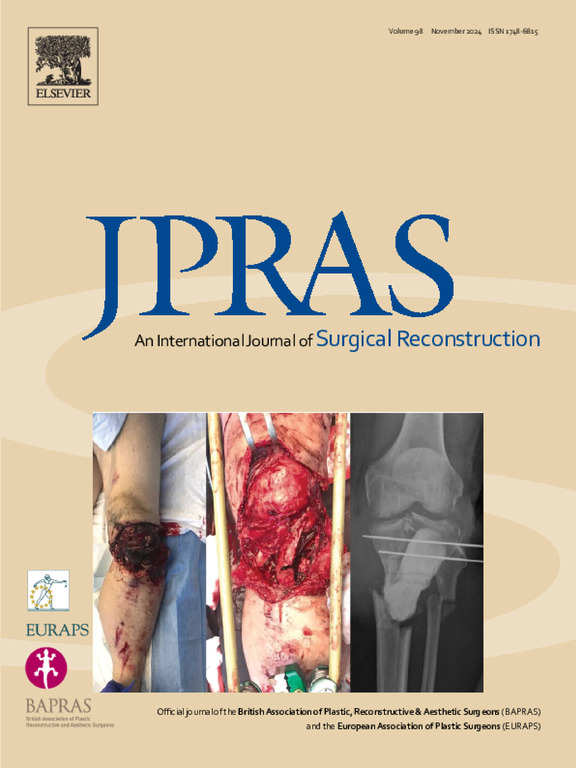手术技术和裂隙宽度对 UCLP 患儿 5 岁时二次手术率和括咽功能的影响。
IF 2
3区 医学
Q2 SURGERY
Journal of Plastic Reconstructive and Aesthetic Surgery
Pub Date : 2024-10-11
DOI:10.1016/j.bjps.2024.10.016
引用次数: 0
摘要
有多种因素可能会影响腭裂患者的语言能力和二次腭裂手术率。本研究的目的是评估在统一手术方案下不同类型的腭裂瓣内成形术。研究还探讨了腭裂宽度和外科医生经验对结果测量的影响。这项横断面研究纳入了 2000-2015 年出生的 62 名单侧唇腭裂患者。根据所使用的手术技术,他们被分为三组。根据牙模测量裂隙宽度。盲人语言病理学家通过单词的咽喉能力综合评分(VPC-Sum)评估咽喉功能。他们对句子中的包咽功能进行了三点评分(VPC-R)。对单词中的目标辅音进行语音转录。计算辅音正确率(PCC)。手术技术与任何结果都无关。使用 VPC-R 时,裂隙宽度与二次腭裂手术率(OR 1.141,95% CI 1.021-1.275,p = .020)和包咽功能不全有关(OR 2.700,95% CI 1.053-6.919,p = .039),但使用 VPC-Sum 时则无关(OR 1.985,95% CI.845-4.662,p = .116)。PCC 与裂隙宽度无关,不同手术技术之间也无差异。根治性肌肉切除术并不比通过腭咽肌加固的耳廓内扩张成形术更有优势。为了准确评估和比较手术技术,有必要对更大年龄组的患者进行随访。与手术技术相比,裂隙宽度对二次手术率和括咽功能的影响更大,但两者都不影响PCC。本文章由计算机程序翻译,如有差异,请以英文原文为准。
The impact of surgical technique and cleft width on the rate of secondary surgery and velopharyngeal function in children with UCLP at 5 years of age
Several factors may influence speech outcome and the rate of secondary palatal surgery in patients with cleft palate. The aim of this study was to evaluate different types of intra-velar veloplasty within an otherwise uniform surgical protocol. The impact of cleft width and the surgeon’s experience on outcome measurements was examined. This cross-sectional study included 62 individuals with unilateral cleft lip and palate born in 2000–2015. Based on the surgical technique used, they were divided into three groups. The cleft width was measured on dental casts. Blinded speech and language pathologists assessed velopharyngeal function with the composite score for velopharyngeal competence (VPC-Sum) for single words. They rated velopharyngeal function on a three-point scale (VPC-R) in sentences. Target consonants in words were phonetically transcribed. The percentage of correct consonants (PCC) was calculated. Surgical technique was not associated with any outcome. Cleft width was associated with the rate of secondary palatal surgery (OR 1.141, 95% CI 1.021–1.275, p = .020) and velopharyngeal insufficiency when using VPC-R (OR 2.700, 95% CI 1.053–6.919, p = .039) but not when using VPC-Sum (OR 1.985, 95% CI.845–4.662, p = .116). PCC was not associated with cleft width and did not differ between surgical techniques. Radical muscle dissection did not exhibit superiority over intra-velar veloplasty reinforced by the palatopharyngeal muscle. Follow-ups at later ages with larger groups will be necessary to evaluate and compare surgical techniques accurately. Cleft width had a greater impact on the rate of secondary surgery and velopharyngeal function than surgical technique, but neither affected the PCC.
求助全文
通过发布文献求助,成功后即可免费获取论文全文。
去求助
来源期刊
CiteScore
3.10
自引率
11.10%
发文量
578
审稿时长
3.5 months
期刊介绍:
JPRAS An International Journal of Surgical Reconstruction is one of the world''s leading international journals, covering all the reconstructive and aesthetic aspects of plastic surgery.
The journal presents the latest surgical procedures with audit and outcome studies of new and established techniques in plastic surgery including: cleft lip and palate and other heads and neck surgery, hand surgery, lower limb trauma, burns, skin cancer, breast surgery and aesthetic surgery.

 求助内容:
求助内容: 应助结果提醒方式:
应助结果提醒方式:


